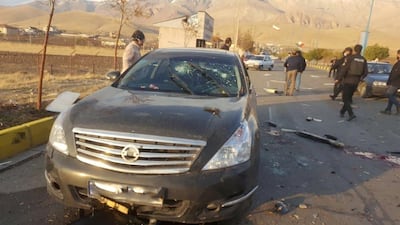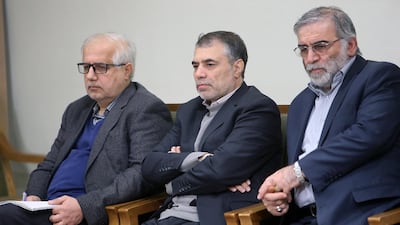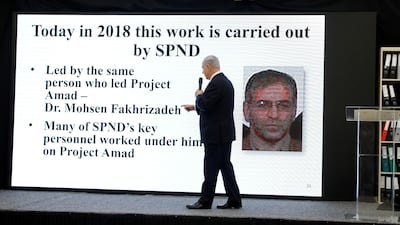The deputy commander of Iran's Islamic Revolutionary Guard Corps said on Sunday that he believed a satellite-controlled machinegun with artificial intelligence was used in last month's assassination of a top nuclear scientist.
Mohsen Fakhrizadeh was driving on a motorway outside Iran's capital Tehran with 11 guards on November 27 when the machinegun zoomed in and fired 13 rounds, Rear Admiral Ali Fadavi told Iranian media.
The machinegun was mounted on a Nissan pick-up truck and was being "controlled online" by satellite.
It used an "advanced camera and artificial intelligence" to carry out the killing, Adm Fadavi told the Mehr news agency.
It is unclear who was behind the killing, but Iran's state-run Press TV claimed that weapons "made in Israel" were found at the scene. Iran has yet to provide any pictures of equipment reportedly recovered at the ambush site.
President Hassan Rouhani last week accused Israel of being responsible for the assassination, saying it was acting as a mercenary for the US.
Western and Israeli governments have long held the belief that Fakhrizadeh was the architect of a secret Iranian nuclear weapons programme. He was reportedly close to Iran's supreme leader, Ayatollah Ali Khamenei, and a member of the IRGC. He was identified in 2011 by the International Atomic Energy Agency as playing a leading role in Iran's nuclear weapons research.
Various accounts of the scientist's death emerged after the attack, with Iran's defence ministry initially saying he was caught in a firefight with his bodyguards.
Fars news agency claimed "a remote-controlled, automatic machinegun" killed him, without giving any sources.
A failure of counterintelligence
Iran's conflicting explanations for what happened led to speculation that the IRGC is trying to deflect attention from what amounts to an embarrassing security breach on its soil.
For such a complex operation to be successful, each element would have to work perfectly, including communication and data links between the various devices used.
Furthermore, the equipment would almost certainly have been custom-made, since military "remote weapons systems" are too large for most civilian vehicles. Equipment for the operation would therefore have had to be smuggled into Iran – itself a dangerous operation.
While the use of a sophisticated remote control weapon cannot be ruled out, the idea that assassins apparently had free reign in Iran to have killed five nuclear scientists since 2010 could be seen as a source of humiliation for the IRGC, who may prefer to portray the killing as an unavoidable act.
Company%20profile
%3Cp%3E%3Cstrong%3ECompany%20name%3A%20%3C%2Fstrong%3EXare%C2%A0%3C%2Fp%3E%0A%3Cp%3E%3Cstrong%3EStarted%3A%20%3C%2Fstrong%3EJanuary%2018%2C%202021%C2%A0%3C%2Fp%3E%0A%3Cp%3E%3Cstrong%3EFounders%3A%20%3C%2Fstrong%3EPadmini%20Gupta%2C%20Milind%20Singh%2C%20Mandeep%20Singh%C2%A0%3C%2Fp%3E%0A%3Cp%3E%3Cstrong%3EBased%3A%20%3C%2Fstrong%3EDubai%C2%A0%3C%2Fp%3E%0A%3Cp%3E%3Cstrong%3ESector%3A%20%3C%2Fstrong%3EFinTech%C2%A0%3C%2Fp%3E%0A%3Cp%3E%3Cstrong%3EFunds%20Raised%3A%20%3C%2Fstrong%3E%2410%20million%C2%A0%3C%2Fp%3E%0A%3Cp%3E%3Cstrong%3ECurrent%20number%20of%20staff%3A%20%3C%2Fstrong%3E28%C2%A0%3C%2Fp%3E%0A%3Cp%3E%3Cstrong%3EInvestment%20stage%3A%20%3C%2Fstrong%3Eundisclosed%3C%2Fp%3E%0A%3Cp%3E%3Cstrong%3EInvestors%3A%20%3C%2Fstrong%3EMS%26amp%3BAD%20Ventures%2C%20Middle%20East%20Venture%20Partners%2C%20Astra%20Amco%2C%20the%20Dubai%20International%20Financial%20Centre%2C%20Fintech%20Fund%2C%20500%20Startups%2C%20Khwarizmi%20Ventures%2C%20and%20Phoenician%20Funds%3C%2Fp%3E%0A
How to keep control of your emotions
If your investment decisions are being dictated by emotions such as fear, greed, hope, frustration and boredom, it is time for a rethink, Chris Beauchamp, chief market analyst at online trading platform IG, says.
Greed
Greedy investors trade beyond their means, open more positions than usual or hold on to positions too long to chase an even greater gain. “All too often, they incur a heavy loss and may even wipe out the profit already made.
Tip: Ignore the short-term hype, noise and froth and invest for the long-term plan, based on sound fundamentals.
Fear
The risk of making a loss can cloud decision-making. “This can cause you to close out a position too early, or miss out on a profit by being too afraid to open a trade,” he says.
Tip: Start with a plan, and stick to it. For added security, consider placing stops to reduce any losses and limits to lock in profits.
Hope
While all traders need hope to start trading, excessive optimism can backfire. Too many traders hold on to a losing trade because they believe that it will reverse its trend and become profitable.
Tip: Set realistic goals. Be happy with what you have earned, rather than frustrated by what you could have earned.
Frustration
Traders can get annoyed when the markets have behaved in unexpected ways and generates losses or fails to deliver anticipated gains.
Tip: Accept in advance that asset price movements are completely unpredictable and you will suffer losses at some point. These can be managed, say, by attaching stops and limits to your trades.
Boredom
Too many investors buy and sell because they want something to do. They are trading as entertainment, rather than in the hope of making money. As well as making bad decisions, the extra dealing charges eat into returns.
Tip: Open an online demo account and get your thrills without risking real money.
MOUNTAINHEAD REVIEW
Starring: Ramy Youssef, Steve Carell, Jason Schwartzman
Director: Jesse Armstrong
Rating: 3.5/5
UAE currency: the story behind the money in your pockets
MATCH INFO
Everton 2 Southampton 1
Everton: Walcott (15'), Richarlison (31' )
Southampton: Ings (54')
Man of the match: Theo Walcott (Everton)













